The Ultimate Guide on Continuous Microwave Basil Leaves Drying Sterilization Dryer Production Line in 2024
Introduction
In 2024, the food processing industry continues to advance, with innovations enhancing efficiency and product quality. One of the significant developments in this sector is the Continuous Microwave Basil Leaves Drying Sterilizing Dryer Processing Line. This cutting-edge technology offers an efficient and reliable solution for the drying and sterilization of basil leaves, ensuring superior quality and safety.
The Continuous Microwave Basil Leaves Drying Sterilizing Dryer Processing Line utilizes microwave energy to uniformly dry and sterilize basil leaves. This method provides several advantages over traditional drying techniques, such as faster processing times, reduced energy consumption, and better retention of the basil's natural color, aroma, and nutrients. The continuous processing line design ensures a steady flow of product, maximizing throughput and operational efficiency.
As experts in the field, we recognize the importance of understanding the benefits and operational principles of this technology. Proper implementation can lead to significant improvements in production quality and efficiency. This guide aims to provide a comprehensive overview of the Continuous Microwave Basil Leaves Drying Sterilizing Dryer Processing Line, highlighting its key features, operational guidelines, and best practices for achieving optimal results.
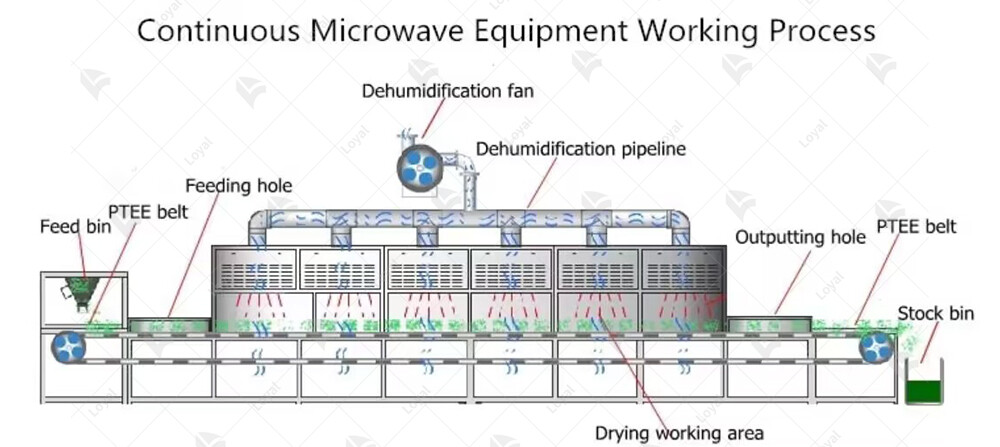
Working principle of continuous microwave basil leaf drying and sterilization drying machine production line
Microwave Technology
The core of the Continuous Microwave Basil Leaves Drying Sterilization Dryer Processing Line lies in its microwave technology. Microwaves generate heat by causing polar molecules in the basil leaves to rotate and produce thermal energy. This internal heating mechanism ensures uniform drying and effective sterilization.
Continuous Process
Unlike batch processing, this production line operates continuously, providing several advantages:
Consistency: Continuous operation ensures consistent product quality.
Efficiency: Reduces processing time compared to traditional methods.
Scalability: Easily scalable to meet varying production demands.
Mesh Belt System
A key component of the production line is the mesh belt system:
Transport: Basil leaves are placed on a mesh belt that moves steadily through the microwave chamber.
Uniform Exposure: Ensures even exposure to microwaves, resulting in uniform drying and sterilization.
Adjustable Speed: The belt speed can be adjusted to control the drying and sterilization time.
Drying Process
The drying process involves removing moisture from basil leaves:
Rapid Moisture Removal: Microwaves penetrate the leaves, causing water molecules to evaporate quickly.
Retention of Nutrients: The rapid drying process helps in retaining the nutritional value and flavor of basil leaves.
Sterilization Process
Sterilization is achieved simultaneously with drying:
Pathogen Elimination: Microwaves effectively kill bacteria, molds, and other pathogens.
Safety and Shelf Life: Enhances the safety and extends the shelf life of the basil leaves.
Control Systems
Advanced control systems ensure precise operation:
Temperature Control: Maintains optimal temperatures for drying and sterilization.
Real-time Monitoring: Continuous monitoring of process parameters to ensure consistent quality.
User Interface: Intuitive interface for easy operation and adjustments.
Conclusion
The Continuous Microwave Basil Leaves Drying Sterilization Dryer Processing Line represents a significant advancement in food processing technology. By understanding its working principle, operators can maximize efficiency, ensure high product quality, and meet the growing demands of the market in 2024.
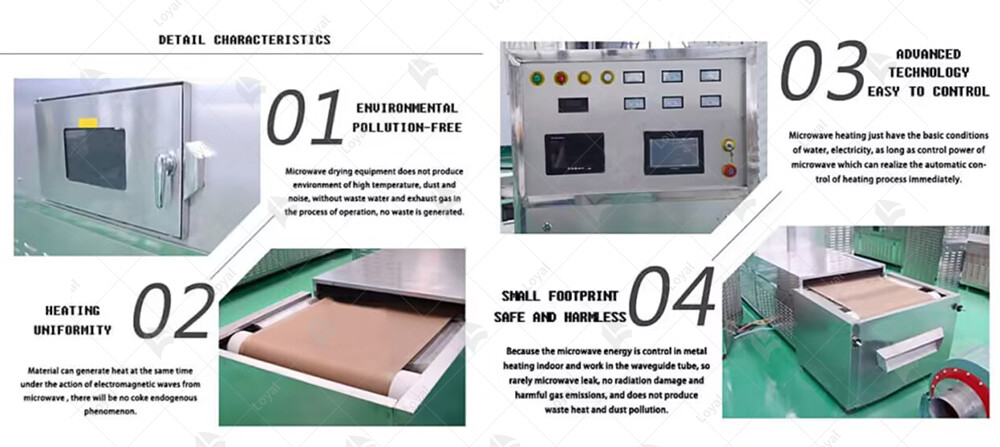
Advantages and disadvantages of continuous microwave basil leaf drying and sterilization drying machine production line
| Advantages | Disadvantages |
| 1. Efficiency | 1. Initial Cost |
| Fast and uniform drying and sterilization. | High initial investment compared to conventional methods. |
| Continuous processing reduces downtime. | |
| 2. Quality Preservation | 2. Technical Expertise Required |
| Maintains color, flavor, and nutritional value of basil leaves. | Requires skilled operators and technicians for maintenance and troubleshooting. |
| Minimizes thermal degradation due to shorter processing time. | |
| 3. Energy Efficiency | 3. Maintenance Costs |
| Consumes less energy compared to traditional drying methods. | Regular maintenance and potential high repair costs. |
| Reduces overall energy costs in the long run. | |
| 4. Enhanced Food Safety | 4. Space Requirements |
| Effective sterilization reduces microbial contamination. | Requires substantial space for installation and operation. |
| Ensures compliance with food safety regulations. | |
| 5. Scalability | 5. Limited Applicability |
| Suitable for large-scale production. | May not be suitable for all types of herbs or leaves. |
| Easy to scale up operations to meet increased demand. |
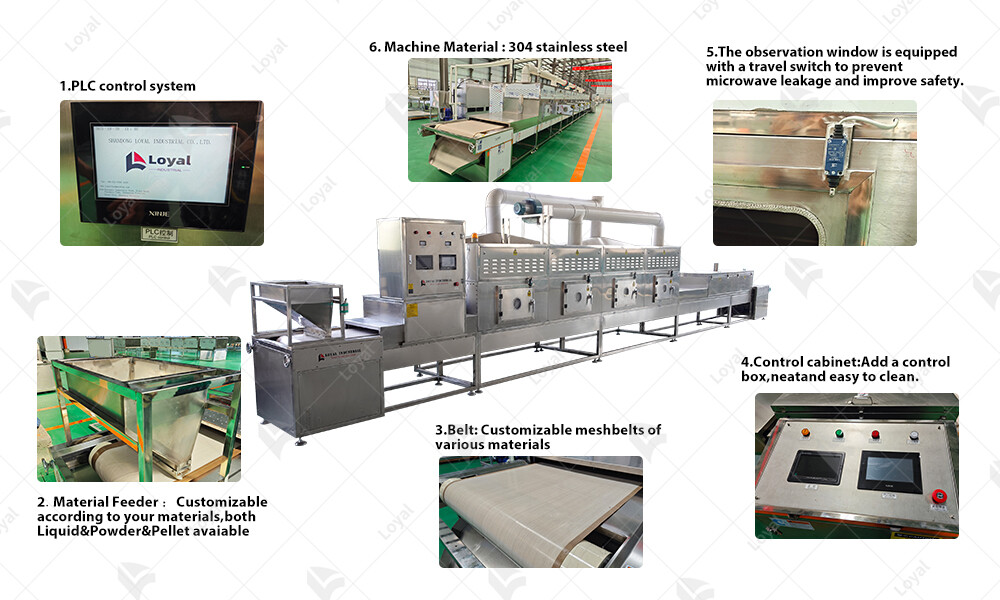
Key components of continuous microwave basil leaf drying and sterilization drying machine
| Component | Description |
| Microwave Generator | Produces microwaves that penetrate basil leaves, ensuring uniform drying and sterilization. |
| Control Panel | User interface for setting and adjusting operational parameters such as power level and belt speed. |
| Mesh Belt Conveyor | Transports basil leaves through the drying and sterilization chambers, ensuring continuous processing. |
| Drying Chamber | Enclosure where microwaves dry the basil leaves by evaporating moisture content. |
| Sterilization Chamber | Section where microwaves eliminate bacteria and pathogens from the basil leaves. |
| Temperature Sensors | Monitor the temperature within the chambers to maintain optimal drying and sterilizing conditions. |
| Moisture Sensors | Measure the moisture content of basil leaves to ensure they reach the desired dryness level. |
| Ventilation System | Removes moisture-laden air from the chambers, maintaining a controlled processing environment. |
| Cooling System | Cools down the dried and sterilized basil leaves before packaging. |
| Feeding System | Mechanism for evenly distributing basil leaves onto the mesh belt conveyor. |
| Discharge System | Collects and outputs the dried and sterilized basil leaves for packaging. |
| Safety Interlocks | Prevents operation when access doors are open, ensuring operator safety. |
| Power Supply Unit | Provides the necessary electrical power for the entire processing line. |
| Exhaust System | Removes excess heat and steam generated during the drying process. |
| PLC Control System | Programmable logic controller for automating and optimizing the entire drying and sterilizing process. |
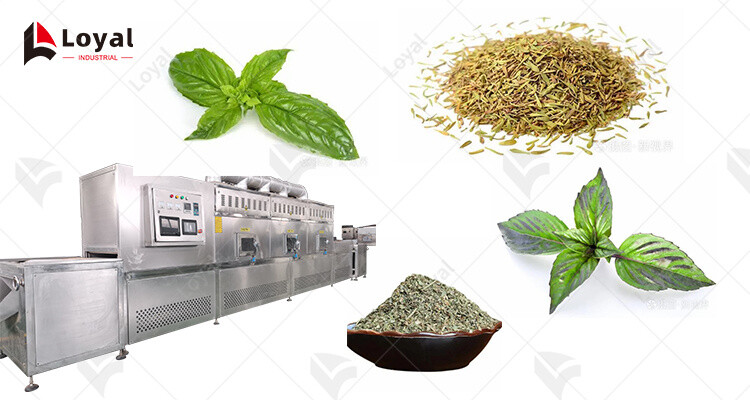
Comparison and advantages of continuous microwave basil leaf drying and sterilization drying with traditional sterilization methods
| Aspect | Continuous Microwave Basil Leave Drying Sterilizing Dryer Processing Line | Traditional Sterilization Methods |
| Drying Speed | Rapid and uniform drying due to microwave penetration | Slower, dependent on external heat transfer |
| Sterilization Efficiency | High efficiency, effectively kills pathogens | Variable, may not evenly sterilize all areas |
| Energy Consumption | Lower, targeted energy application directly to basil leaves | Higher, requires heating entire environment |
| Product Quality | Maintains flavor, color, and nutritional content | Potential loss of flavor, color, and nutrients |
| Operational Costs | Lower long-term costs due to efficiency | Higher long-term costs, energy-intensive |
| Automation | High, allows for continuous processing and reduced manual labor | Lower, often requires more manual intervention |
| Space Requirements | Compact, integrated system | Larger footprint, needs more space for batch processing |
| Environmental Impact | Lower, more energy-efficient and less waste | Higher, more energy and resource-intensive |
| Maintenance | Regular but straightforward maintenance | More complex, may require frequent and extensive upkeep |
| Scalability | Easily scalable for increased production | Limited scalability, batch size constraints |
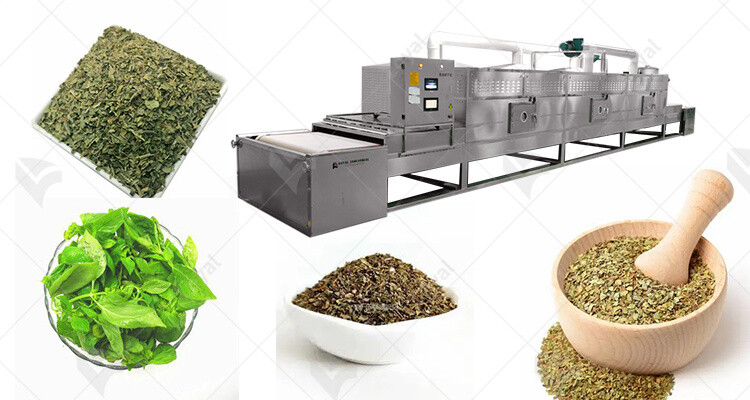
Types of continuous microwave basil leaf drying and sterilization drying machine
When it comes to basil leaf processing, choosing the right drying and sterilization equipment is paramount to maintain product quality and safety. In 2024, the market offers various types of continuous microwave basil leaf drying and sterilization machines tailored to meet different production needs.
1. Conveyor Belt Microwave Dryers
Conveyor belt microwave dryers are popular for their continuous operation and uniform drying capabilities. Basil leaves are placed on a conveyor belt, where they pass through a microwave chamber. Microwaves penetrate the leaves, effectively removing moisture while sterilizing them. These machines are ideal for large-scale production lines requiring high throughput.
2. Batch Microwave Dryers
Batch microwave dryers are suitable for smaller production volumes or businesses with limited space. In these machines, basil leaves are loaded into trays or baskets and placed inside a microwave chamber. The chamber is then sealed, and microwaves are applied to dry and sterilize the leaves. While batch processing is slower than continuous methods, it offers flexibility and precision in drying.
3. Hybrid Microwave-Infrared Dryers
Hybrid microwave-infrared dryers combine the benefits of microwave and infrared technologies. Basil leaves are exposed to both microwaves and infrared radiation, enhancing drying efficiency and reducing processing time. These machines are versatile and can accommodate varying moisture levels and product sizes.
4. Vacuum Microwave Dryers
Vacuum microwave dryers operate under reduced pressure, allowing for lower drying temperatures and faster processing times. Basil leaves are placed in a vacuum chamber, where microwaves are applied to remove moisture. The vacuum environment helps preserve the leaves' color, flavor, and nutritional content, making it ideal for high-quality basil products.
Conclusion
Choosing the right continuous microwave basil leaf drying and sterilization machine is essential for optimizing production efficiency and product quality in 2024. Whether you opt for conveyor belt dryers, batch systems, hybrid machines, or vacuum dryers, each type offers unique advantages to suit different processing requirements. By understanding the options available, you can select the most suitable equipment for your basil processing line, ensuring consistent and superior results.

Technical parameters
| Technical Parameters Of Continuous Microwave Dryer Industrial Microwave Drying Machine | |||||
| Model | Size LWH(Can be customized according to the customer's requirements) | Output power | Dewaterability | Sterilization capacity | Baking and Roasting capacity (Depends on different raw material) |
| LY-10KW | 5000mm825mm1750mm | ≥10KW | 10KG/Hour | 100KG/Hour | 30-50KG/Hour |
| LY-20KW | 8000mm825mm1750mm | ≥20KW | 20KG/Hour | 200KG/Hour | 60-100KG/Hour |
| LY-30KW | 8500mm1160mm1750mm | ≥30KW | 30KG/Hour | 300KG/Hour | 90-150 KG/Hour |
| LY-40KW | 10000mm1160mm1750mm | ≥40KW | 40KG/Hour | 40KG/Hour | 120-200KG/Hour |
| LY-50KW | 12500mm1160mm1750mm | ≥50KW | 50KG/Hour | 500KG/Hour | 150-250KG/Hour |
| LY-60KW | 13500mm1450mm1750mm | ≥60KW | 60KG/Hour | 600KG/Hour | 180-300KG/Hour |
| LY-70KW | 13500mm1500mm1750mm | ≥70KW | 70KG/Hour | 700KG/Hour | 210-350KG/Hour |
| LY-80KW | 13500mm1650mm1750mm | ≥80KW | 80KG/Hour | 800KG/Hour | 240-400KG/Hour |
| LY-100KW | 16800mm1650mm1750mm | ≥100KW | 100KG/Hour | 1000KG/Hour | 300-500KG/Hour |
| LY-150KW | 22400mm1850mm1750mm | ≥150KW | 150KG/Hour | 1500KG/Hour | 450-750KG/Hour |
| LY-200KW | 27000mm1850mm1750mm | ≥250KW | 250KG/Hour | 2500KG/Hour | 750-1250/Hour |
| LY-300KW | 32000mm1850mm1750mm | ≥300KW | 300KG/Hour | 3000KG/Hour | 900-1500KG/Hour |
| Power Supply | 380V±10% 50Hz±1% Three-Phase Five-Wire | ||||
| Microwave Output Frequency | 2450±50Mhz | ||||
| Microwave Input Apparent Power | ≤168Kva | ||||
| Microwave Output Power | ≥120Kw | ||||
| Microwave Power Adjustment Range | 0-30Kw(Adjustable) | ||||
| Ambient Temperature | -5-40°C | ||||
| Relative Humidity | ≤80%, Surrounding Environment:No Corrosive Gas, Conductive Dust And Explosive Gas | ||||
| Transmission Speed | 0-10m/Min(Adjustable) | ||||
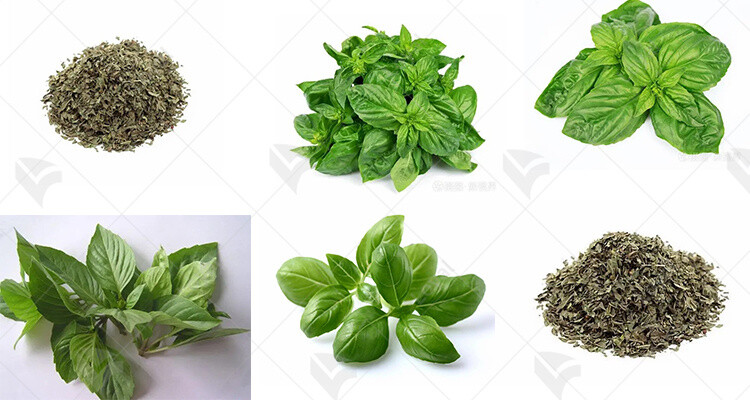
Application of continuous microwave basil leaf drying and sterilization drying machine production line
When considering the application of a continuous microwave basil leaf drying and sterilization drying machine production line, several key factors should be taken into account to ensure optimal results. Here's a comprehensive guide on how to effectively utilize this innovative technology in basil processing:
1.Preparation of Basil Leaves: Start by harvesting fresh basil leaves from the garden or sourcing them from a reputable supplier. Ensure that the leaves are clean and free from any contaminants or blemishes. Wash the leaves thoroughly and allow them to dry naturally or pat them gently with a clean cloth to remove excess moisture.
2.Loading the Machine: Carefully load the prepared basil leaves onto the conveyor belt of the continuous microwave basil leaf drying and sterilization drying machine. Arrange the leaves in a single layer to ensure uniform exposure to the microwave energy.
3.Adjusting Parameters: Set the appropriate parameters on the machine's control panel based on the specific requirements of basil drying and sterilization. This includes adjusting the microwave power level, conveyor belt speed, and temperature settings to achieve the desired outcome.
4.Initiating the Process: Start the machine to initiate the continuous drying and sterilization process. As the basil leaves pass through the microwave chamber, they are subjected to controlled levels of microwave energy, which effectively removes moisture and sterilizes the leaves, preserving their flavor, color, and nutritional value.
5.Monitoring the Operation: Monitor the operation of the machine closely to ensure smooth and efficient processing of the basil leaves. Keep an eye on the temperature, moisture content, and overall quality of the leaves throughout the drying and sterilization process.
6.Quality Control: Periodically sample the dried and sterilized basil leaves to assess their quality and consistency. Conduct sensory evaluations to ensure that the leaves meet the desired standards in terms of aroma, flavor, texture, and appearance.
7.Packaging and Storage: Once the basil leaves have been adequately dried and sterilized, remove them from the machine and package them in suitable containers or bags. Ensure proper labeling with relevant information such as the date of processing and expiry date. Store the packaged basil leaves in a cool, dry place away from direct sunlight to maintain their freshness and shelf life.
8.Cleaning and Maintenance: After completing the processing, clean the machine thoroughly to remove any residual debris or contaminants. Follow the manufacturer's instructions for regular maintenance and servicing to keep the machine in optimal condition for future use.
By following these steps, you can effectively utilize a continuous microwave basil leaf drying and sterilization drying machine production line to process basil leaves with efficiency, consistency, and quality in 2024 and beyond.
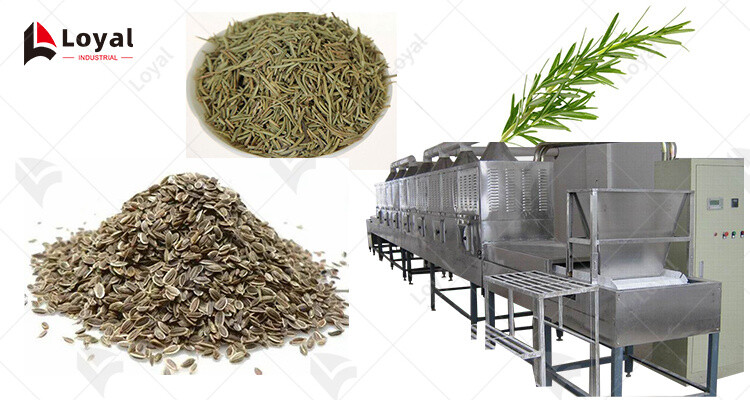
Technological progress and innovation of continuous microwave basil leaf drying and sterilization drying machine
In the ever-evolving landscape of food processing technology, continuous microwave basil leaf drying and sterilization drying machines stand out as a pinnacle of innovation and efficiency. These machines represent a significant leap forward in the industry, offering unparalleled benefits for basil leaf processing.
Microwave Technology Advancements
Continuous microwave basil leaf drying and sterilization drying machines harness the power of advanced microwave technology to achieve rapid and uniform drying. Unlike traditional drying methods, which may result in uneven drying and loss of flavor and nutrients, microwave drying ensures consistent quality and preserves the natural characteristics of basil leaves.
Integration of Sterilization Functionality
One of the key features of continuous microwave basil leaf drying and sterilization drying machines is their ability to simultaneously sterilize the leaves during the drying process. This integration of sterilization functionality not only enhances food safety by eliminating harmful pathogens but also extends the shelf life of the dried basil leaves, ensuring longer-lasting freshness and quality.
Efficiency and Productivity
Continuous operation is a hallmark of these machines, allowing for uninterrupted processing and maximizing productivity. With adjustable settings and precise control mechanisms, operators can tailor the drying and sterilization parameters to meet specific requirements, ensuring optimal results with minimal energy consumption.
Quality Assurance and Compliance
Quality assurance is paramount in food processing, and continuous microwave basil leaf drying and sterilization drying machines are designed with this principle in mind. Rigorous testing and adherence to industry standards ensure that the machines deliver consistently high-quality output while complying with regulatory requirements for food safety and hygiene.
Environmental Sustainability
In addition to their performance benefits, continuous microwave basil leaf drying and sterilization drying machines also contribute to environmental sustainability. By reducing energy consumption and minimizing waste, these machines help to mitigate the environmental impact of food processing operations, aligning with the industry's growing emphasis on sustainability and responsible resource management.
Conclusion
Continuous microwave basil leaf drying and sterilization drying machines represent a significant technological advancement in the field of food processing. With their innovative features, efficiency, and commitment to quality and sustainability, these machines are poised to revolutionize the production of dried basil leaves in 2024 and beyond, offering unparalleled benefits for manufacturers and consumers alike.
Reference
The following are five authoritative foreign literature websites in the field of industrial microwaves:
1. IEEE Xplore Digital Library
Website: https://ieeexplore.ieee.org/
2.ScienceDirect
Website: https://www.sciencedirect.com/
3. SpringerLink
Website: https://link.springer.com/
4. Wiley Online Library
Website: https://onlinelibrary.wiley.com/
5. PubMed
Website: https://pubmed.ncbi.nlm.nih.gov/
 Telephone :+86-531-55583139
Telephone :+86-531-55583139 WhatsApp :+86 13256674591
WhatsApp :+86 13256674591 Email :
Email :










